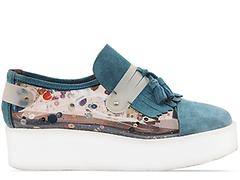Podiatrist Shoe Recommendations
for Patients with Hallux Limitus/Rigidus
who still want height and fashion.
If you've been diagnosed with Hallux Limitus/Rigidus, you understand the frustration of having this condition when if comes to finding fashionable shoes. Getting diagnosed with Hallux Limitus doesn't mean that you're relegated to a life of orthopedic shoes. You simply need to understand exactly what you are looking for in a shoe so that you will be able to find something that is comfortable and suits your sense of style.
Hallux Limitus means that you have limited range of motion of the first toe joint whether it is from injury, arthritis, gout, degenerative joint disease or the genetic biomechanical structure of your foot. Hallux Rigidus means that the condition is so bad that you have no motion through the first toe joint. What this means is that if you try to wear any shoes with a heel, it results in significant pain and more injury to the already beleaguered joint.
So, do you have Hallux Limitus, don't want to wear orthopedic shoes but would still love stand several inches taller? A lovely website called Solestruck.com has a variety of shoes that fit the bill. I do not recommend all of their shoes (you'll understand why when you see all the 'Lady Gaga' shoes - love her music but not her shoes!) and I suspect you'll either love them or hate them. I think their shoes are awesome but I will confess that Callie, our office manager, shot me a look of horror when I showed her the shoes I was ordering. She claimed she would never wear them in a million years but did concede that she thought I could pull off the look (she then did a bee-bop imitation of me walking through the office in my new shoes) saying that Dr. McCarthy has her own sense of style, which includes not caring what anyone thinks, which I took as a compliment! Another confession - Callie is much cooler than me so don't say I didn't give you a heads-up... :)
Patients with Hallux Limitus/Rigidus need four things in a shoe:
1. A thick, rigid sole with no motion. If you can bend of flex the shoe, it is not good enough for you and will cause more pain and damage to the joint.
2. A wide and preferably soft toe-box so there is no pressure on the toes. As a side note, this is particularly important if you are trying to treat a fungal infection of the toenails (please see my article on this blog about toenail fungus by using the search box). It is also important for anyone suffering with painful hammertoes, bunions, corns, Morton's Neuromas, ect.
3. Rearfoot Control. It's important that every shoe have at least a strap around your rearfoot. Otherwise, you are forcing all your tendons, joints, ligaments, and muscles to work harder to stay in the shoe, which causes a variety of problems including 'tired leg syndrome' as well as knee, hip and lower back pain. If you don't have rearfoot control, you are gripping down your toes to stay in the shoe, which is aggravating your Hallux Limitus condition.
4. Arch Support. I would recommend that your add a custom-molded dress orthotic to these shoes to give you more arch support, which will help with stopping or slowing the progression of your Hallux Limitus/Rigidus condition as well as help with knee, hip and lower back pain. Many insurance companies will pay for custom molded inserts because they understand that getting patients into proper inserts helps to prevent surgery. If you are a patient of ours, please call Callie (480-563-5115) and ask her to check with your insurance company to see if this benefit is covered.
One final note, some of you may not like the looks of these shoes but - don't knock 'em till you try 'em! I have a patient who is a young, stylish and active woman who has such severe Hallux Rigidus that the only shoe she was able to wear comfortably was a leopard-skin pattern fuzzy bedroom slipper because it had a thick, rigid sole similar to the ones below. She wore that bedroom slipper with every outfit for over a year until she found something that was similar to the below shoes that she could wear with comfort! They are hard to find but they are out there so - don't give up! If you don't like these, keep looking till you find something that you like that has a thick rigid sole, wide toebox, arch support and rearfoot control.
Jeffrey Campbell - Mad Man
The Damned
Jeffrey Campbell - Weller
August
Plateau Jung
Minimarket
Slingback Platform Sneaker
Opening Ceremony
June
I hope this was helpful and I wish you a Healthy, Fun, Active
Happy New Years!!
Dr. Cathleen A. McCarthy
:)








